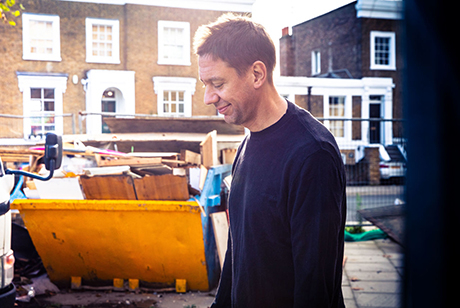New York - Bob Isherwood, Worldwide Creative Director of Saatchi & Saatchi, today announces the contenders to win the fifth Saatchi & Saatchi Award For World Changing Ideas.
Held biennially, this global competition was established by Saatchi & Saatchi to spotlight, celebrate and promote ideas that have the potential to change the world of the individual, of groups of people with particular needs, or the whole world.
Bob Isherwood, convenor of the Award, said, "The ingenuity, brilliance and commitment of our finalists is humbling. We have some very big answers to some very big questions here, and their potential to change the world of so many people is self-evident. These ideas are simply inspirational."
The Award attracts an incredibly broad range of entries, which is reflected in the line up of finalists for this year's prize.
The winner will be announced at a high profile ceremony in New York on Thursday 21st February 2008, where the following ten finalists will exhibit their innovations:
Acuset IV Controller (New Zealand), Crossbreed Collapsible Wheel (UK), LifeStraw? (Switzerland), One Laptop per Child (USA), PerspectaRAD: 3-D Display for Cancer Treatment (USA), Printing Skin and Bones (UK), Restoring Sight to the Blind (USA), Speaking Books (South Africa), Village Phone (USA) and Wadsworth Brain-Computer Interface (USA)
The judging panel for the 2007 Award was announced earlier this month. It is a line up of outstanding individuals, all well known experts in their field and no strangers to innovation themselves - Edward de Bono, Peter Gabriel, HRH Prince Hassan, Malcolm McLaren, Carolyn Porco and Philippe Starck.
At the February 21st Award ceremony, Edward de Bono will present his "Medal For Thinking" to the finalist whose idea best meets Edward's criteria of 'simple, practical and effective'.
The US $100,000 prize is made up of US$50,000 cash and the equivalent of US$50,000 in Saatchi & Saatchi marketing consultancy.
About the Finalists
Acuset IV Controller (New Zealand)
Intravenous Infusion (IV) is the world's most common medical procedure. In the developing world, dangerously inaccurate roller clamps are used. This US$6 reusable IV flow controller is affordable, simple to use, accurate and precise. Relatively untrained operators can achieve an accuracy and precision similar to the US$2,000 alternative used in the developed world. The Acuset IV Flow Controller has the potential to save millions of lives. www.medicinemondiale.org
Crossbreed Collapsible Wheel (UK)
Has a segmented, hinged rim. It allows the wheel to fold down from a rigid circular shape to a flattened blade-like form in one easy, flowing motion. The tyre remains fully inflated and in place on the rim. Opens up possibilities for full size bicycles or wheelchairs that could be folded into a package the size and shape of a golf bag and therefore much more easily placed in cars and taxis. www.duncfitz.co.uk
LifeStraw® (Switzerland)
A highly portable, personal, water-purification tool that turns even the dirtiest water into safe drinking water by filtering out bacteria, viruses and parasites. Provides safe drinking water for one person for a whole year. LifeStraw® is vitally important for women, children and people with compromised immune systems, who are especially susceptible to water-born diseases. For the more than one billion people who lack access to safe drinking water in the developing world, LifeStraw® could mean the difference between life and death. www.lifestraw.com
One Laptop per Child (USA)
The OLPC laptop features new designs for a more compact, energy-efficient, and ecologically friendly computer, with a new user interface, Sugar, created especially for children. The aim is that every child in the developing world should have one in order to 'learn learning'. The OLPC Foundation hopes to eliminate illiteracy and poverty through education with the OLPC laptop. www.laptop.org
PerspectaRAD 3-D Display for Cancer Treatment (USA)
Uses special optics and software to project hologram-like floating 3-D images of the patient's anatomy and cancer site from standard CT scans. The "crystal ball" image can be seen from any angle without the need for special eyewear. This enables the oncology team to prepare a more accurate and effective radiation treatment plan - a critical step in eradicating cancer. www.actuality-systems.com
Printing Skin and Bones (UK)
Uses inkjet printing technology to fabricate complex tissue scaffolds on which cells can be grown. The later aim is to use inkjet printing to build 3-D structures that contain both the living cells and the scaffold materials. The ability to print skin and bone and, ultimately, whole artificial organs is a possibility. www.manchester.ac.uk/press/newsarchive/title,10639,en.htm
Restoring Sight to the Blind (USA)
A visual prosthesis will help make blindness a treatable condition by bypassing a diseased or damaged eye and sending signals directly to the part of the brain that normally receives input from the healthy retina. The World Health Organisation estimates there are 45 million people who are blind, and 135 million with low vision. This idea will potentially help these millions of people to see once again. http://pz.med.harvard.edu/restoring-sight-to-the-blind
Speaking Books (South Africa)
Speaking Books have embedded soundtracks in local languages, dealing with life-threatening health issues including AIDS, TB, Malaria and mental health. By using an adaptation of children's book technology - the talking book - South Africa's largest mental health NGO is able to overcome adult illiteracy, enabling patients and care workers to identify illnesses, to know where to go for treatment and how to take their medication to stay alive. www.sadag.co.za
Village Phone (USA)
A 'Business in a Box' that provides telecommunications coverage and business opportunities to poor rural populations in developing countries. Using microfinance loans, grassroots entrepreneurs buy the kit and then rent the use of the phone to their community. So communities are able to contact families and friends, as well as access information about healthcare, market prices, news and danger alerts. www.grameenfoundation.org/what_we_do/technology_programs/village_phone/
Wadsworth Brain-Computer Interface (USA)
The Wadsworth BCI enables totally paralyzed people to communicate and control their environment with brain signals alone. The user wears a cloth electrode cap to detect brain waves that are then translated into outputs such as word-processing, speech, e-mail, environmental control, or movements of robotic devices. The Wadsworth BCI is the only BCI in the world that gives independent communication to totally paralyzed people for daily home use. www.bciresearch.org/html/saatchi.html
Previous finalists have ranged from a tornado early-warning system, self-adjusting spectacles, a sonar system that enables the visually-impaired to 'see' with their ears, a compound that can replicate the sensitivity of human skin, a new kind of aeroplane, a storage system for the world's languages and viable electric lighting for the developing world.
The 2005 recipients of the World Changing Ideas Award were two students at Royal College of Art of London responsible for developing Concrete Canvas, rapidly deployable hardened shelters for victims of natural or man-made disasters.
To find out more, visit www.saatchi.com/worldchanging













